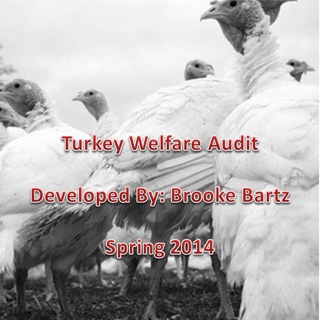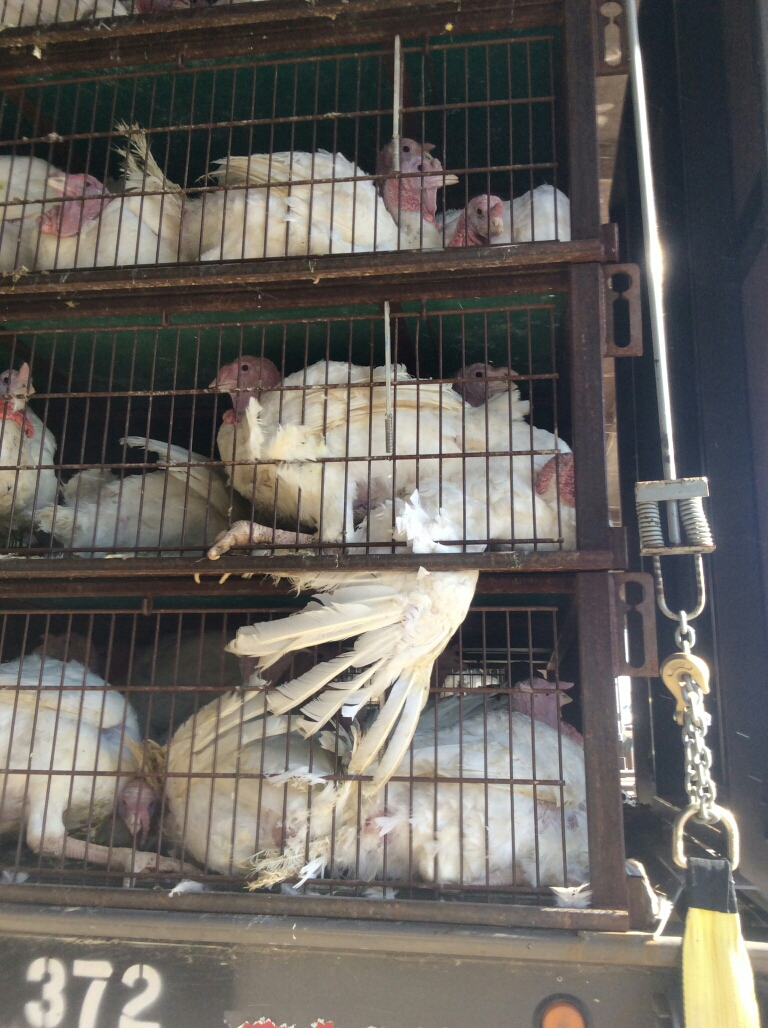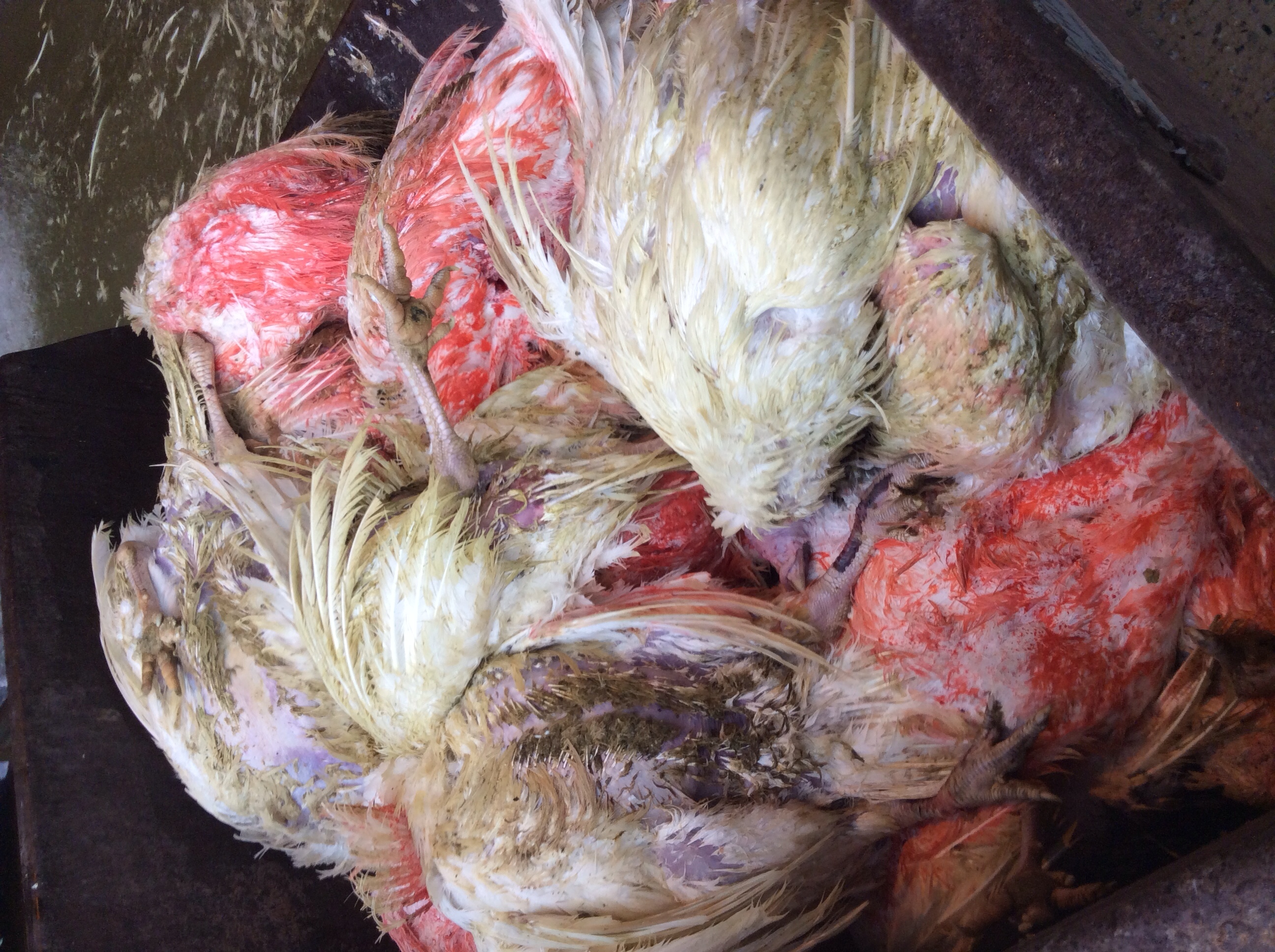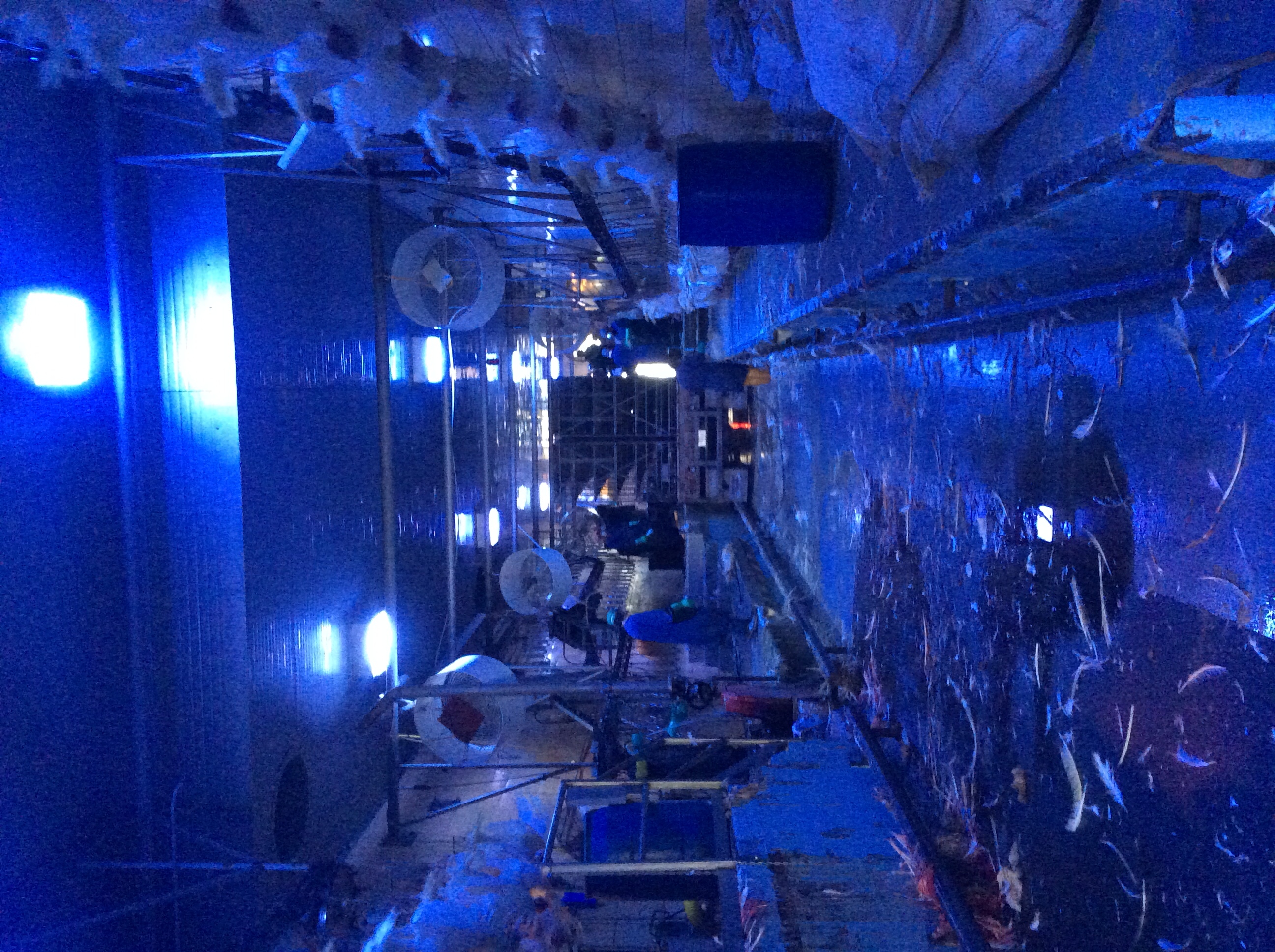Information
-
Document No.
-
Started On:
Plant Documentation
General Plant Documentation
-
Plant Location: Newberry, SC
-
Plant Contact: Ray Cheeks, Raw Processing Manager
-
Core Criteria 1: Plant Transportation Policy
-
1. Plant has written animal welfare policy for animals once they have been received into the plant:
-
2. Mechanisms are in place to minimize travel time to facility:
-
3. Emergency plans in place for animals in transit:
-
4. Availability of acceptable euthanasia tools for turkeys:
-
5. Maintenance records for euthanasia equipment, proper storage, and employee documentation of training for euthanasia are available:
-
6. Pre-market feed withdrawal is less than or equal to 12 hours before loading turkeys for transport:
-
7. All personnel that handle turkeys have been trained according to Kraft Foods policies and have current documentation of training:
Pre-Processing Live Holding Area
-
Plant Location: Newberry, SC
-
Core Criteria 2: Trailers in Pre-Processing Holding Area
-
Five individual trailers will be audited at random at the live animal holding docks and the overall scores of the five trailers will be combined for overall scoring.
-
Temperature at Trailer Holding Docks (Thermometers are mounted by Dock 8 & Dock 26):
-
Add media
-
1) Trailer Number and Dock: (example: 213, 12)
-
The temperature is: (select a choice)<br>
-
Fans must be on for proper ventilation
-
Fan is turned on:
-
Fans must be on for proper ventilation
-
Fan is turned on:
-
Fans must be on for proper ventilation
-
Fan is turned on:
-
Misters must be turned on to maintain proper humidity.
-
Misters are turned on:
-
1. Trailer loaded at proper density depending on weather conditions:
-
Document trailer so that the grower can be notified of the problem, especially if this is a reoccurring issue.
-
2. Coops are in good repair (i.e. No sharp edges, broken latches, etc.):
-
Document what needs to be repaired on the trailer and mark trailer as defective with yellow tape.
-
3. Stocking density allows turkeys to be in a single layer:
-
Document trailer so the the grower can be notified of the problem.
-
4. Are all animals properly loaded in coops (i.e. No wings, feet, beaks, etc. caught in hinged doors):
-
Document trailer so the the grower can be notified of the problem.
-
Example of caught wing below:
-
2) Trailer Number and Dock:
-
The temperature is: (select a choice)<br>
-
Fans must be on for proper ventilation
-
Fan is turned on:
-
Fans must be on for proper ventilation
-
Fan is turned on:
-
Fans must be on for proper ventilation
-
Fan is turned on:
-
Misters must be turned on to maintain proper humidity.
-
Misters are turned on:
-
1. Trailer loaded at proper density depending on weather conditions:
-
Document trailer so that the grower can be notified of the problem.
-
2. Coops are in good repair (i.e. No sharp edges, broken latches, etc.):
-
Document what needs to be repaired on the trailer and mark trailer as defective with yellow tape.
-
3. Stocking density allows turkeys to be in a single layer:
-
Document trailer so that the grower can be notified of the problem.
-
4. Are all animals properly loaded in coops (i.e. No wings, feet, beaks, etc. caught in hinged doors):
-
Document trailer so the the grower can be notified of the problem.
-
3) Trailer Number and Dock:
-
The temperature is: (select a choice)<br>
-
Fans must be on for proper ventilation
-
Fan is turned on:
-
Fans must be on for proper ventilation
-
Fan is turned on:
-
Fans must be on for proper ventilation
-
Fan is turned on:
-
Misters must be turned on to maintain proper humidity.
-
Misters are turned on:
-
1. Trailer loaded at proper density depending on weather conditions:
-
Document trailer so that the grower can be notified of the problem.
-
2. Coops are in good repair (i.e. No sharp edges, broken latches, etc.):
-
Document what needs to be repaired on the trailer and mark trailer as defective with yellow tape.
-
3. Stocking density allows turkeys to be in a single layer:
-
Document trailer so the the grower can be notified of the problem.
-
4. Are all animals properly loaded in coops (i.e. No wings, feet, beaks, etc. caught in hinged doors):
-
Document trailer so the the grower can be notified of the problem.
-
4) Trailer Number and Dock:
-
The temperature is: (select a choice)<br>
-
Fans must be on for proper ventilation
-
Fan is turned on:
-
Fans must be on for proper ventilation
-
Fan is turned on:
-
Fans must be on for proper ventilation
-
Fan is turned on:
-
Misters must be turned on to maintain proper humidity.
-
Misters are turned on:
-
1. Trailer loaded at proper density depending on weather conditions:
-
Document trailer so that the grower can be notified of the problem.
-
2. Coops are in good repair (i.e. No sharp edges, broken latches, etc.):
-
Document what needs to be repaired on the trailer and mark trailer as defective with yellow tape.
-
3. Stocking density allows turkeys to be in a single layer:
-
Document trailer so the the grower can be notified of the problem.
-
4. Are all animals properly loaded in coops (i.e. No wings, feet, beaks, etc. caught in hinged doors):
-
Document trailer so the the grower can be notified of the problem.
-
5) Trailer Number and Dock:
-
The temperature is: (select a choice)<br>
-
Fans must be on for proper ventilation
-
Fan is turned on:
-
Fans must be on for proper ventilation
-
Fan is turned on:
-
Fans must be on for proper ventilation
-
Fan is turned on:
-
Misters must be turned on to maintain proper humidity.
-
Misters are turned on:
-
1. Trailer loaded at proper density depending on weather conditions:
-
Document trailer so that the grower can be notified of the problem.
-
2. Coops are in good repair (i.e. No sharp edges, broken latches, etc.):
-
Document what needs to be repaired on the trailer and mark trailer as defective with yellow tape.
-
3. Stocking density allows turkeys to be in a single layer:
-
Document trailer so that the grower can be notified of the problem.
-
4. Are all animals properly loaded in coops (i.e. No wings, feet, beaks, etc. caught in hinged doors):
-
Document trailer so the the grower can be notified of the problem.
DOA Rendering Bin
Core Criteria 3: Lives Birds in DOA Bin
-
No LIVE bird should be discarded as a DOA. Injured or sick birds removed from processing must be properly euthanized before placement into the DOA bin. A live bird in the DOA bin is a major non-conformance. Non-comformances must be recorded and corrective actions made in all circumstances. If a non-conformance is witnessed by the auditor, it results in an automatic audit failure and will result in the retraining of ALL employees involved in bird processing.
-
Any live birds in DOA bin:
-
Immediate corrective action required. Contact proper plant personnel and document incidence below.
-
Add media
Unloading Dock
Core Criteria 4: Live Dock Processing
-
One trailer will be audited at random in the Live Dock. If the trailer fails according to the outlined criteria below, audit an additional trailer and average the two together.
-
1) Trailer Number:
-
1. Trailer has been properly driven into the live bay to ensure ease during unloading:
-
2. Proper lighting for unloading turkeys is used:
-
3. Adequate staff available for receiving/shackling turkeys:
-
4. Proper sized shackles are used for the size of the turkeys:
-
5. Calming tools are used to keep turkeys from becoming stressed (i.e. quieting belts, curtains, etc.)
-
6. Total Number of DOAs on Trailer (count number of turkeys in DOA bin located on the front of the truck after truck is completely unloaded):
-
Is this an acceptable amount of DOAs allotted per truck:
-
Enter reasoning below for an unusually high number of DOAs (i.e. Heat related, off feed to long, etc.):
-
Add media
-
Because the first trailer had too many DOAs on the trailer, audit an additional trailer so that the two trailers can be averaged together:
-
2) Trailer Number:
-
1. Trailer has been properly driven into the live bay to ensure ease during unloading:
-
2. Proper lighting for unloading turkeys is used:
-
3. Adequate staff available for receiving/shackling turkeys:
-
4. Proper sized shackles are used for the size of the turkeys:
-
5. Calming tools are used to keep turkeys from becoming stressed (i.e. quieting belts, curtains, etc.)
-
6. Total Number of DOAs on Trailer (count number of turkeys in DOA bin located on the front of the truck after truck is completely unloaded):
-
Does the amount exceed the maximum amount of DOAs allotted per truck:
-
Enter reasoning below for an unusually high number of DOAs (i.e. Heat related, off feed to long, etc.):
-
Add media
Shackle Efficacy
Core Criteria 5: Shackle Score
-
Birds must be monitored to ensure that they have been properly shackled by having both legs properly restrained and with the turkey's back towards the hanger (right). Document shackle score below for 100 birds. Keep track of birds by using metal chains attached to shackles (left).
How to score shackling:
1. Birds have been split into groups of ten (1-10, 11-20, 21-30, etc.)
2. Count the number of birds correctly shackled out of 100 total.
3. After 100 birds have been audited, if there is less than 98% correctly shackled, select " no" for the final answer and fill in the questions that follow the question. (i.e. Worker error, mechanical error, or other reason). -
Birds 1-10: How many animals were properly shackled?
-
Birds 11-20: How many animals were properly shackled?
-
Birds 21-30: How many animals were properly shackled?
-
Birds 31-40: How many animals were properly shackled?
-
Birds 41-50: How many animals were properly shackled?
-
Birds 51-60: How many animals were properly shackled?
-
Birds 61-70: How many animals were properly shackled?
-
Birds 71-80: How many animals were properly shackled?
-
Birds 81-90: How many animals were properly shackled?
-
Birds 91-100: How many animals were properly shackled?
-
After 100 birds have been counted, was there a correct shackling percentage > 98%?
-
Audit has been automatically failed and the shackles need to be repaired or the personnel handling the birds need to be re-trained. Document time that this portion was completed and what time the shackles need to be fixed or when personnel need to be retrained by.
-
Personnel needs to be re-trained:
-
Time personnel need to be re-trained by:
-
Shackles are in need of repair:
-
Time shackles need to be repaired by:
-
Other needed correction:
-
Task to be completed:
-
Task must be completed by:
Acts of Abuse (1)
Core Criteria 6: Willful Acts of Abuse/Egregious Acts
-
Any willful act of abuse/egregious act grounds as an automatic failure an in need of immediate corrective action.
Willful acts include but are not limited to:
1. Shackling a severely injured bird
2. Lifting a bird solely by its feathers
3. Hitting or beating an animal
4. Any other handling techniques other than what is listed in the DPS training document -
Any willful acts observed?
-
Audit has been failed. Immediate corrective action needed. Contact proper plant personnel immediately. Document incidence below:
-
Add media
Stunning Efficacy
Core Criteria 7: Stunning Efficacy
-
Score 100 turkeys during the specified shift.
Scoring Guidelines:
Stunned Correctly: Animal is completely insensible to pain. No signs of returning to sensibility seen.
Ineffective Stun: Animal shows some type of response associated with returning to consciousness.
Things to look for during audit that indicate a proper stun
1) No corneal reflex
2) No spontaneous blinking
3) No rhythmic breathing
4) No righting reflex
*Wing flapping should not be used as the primary sign of sensibility. Although this can be associated with returning to sensibility, other signs outlined above must be used to determine the true state if the bird. -
Birds 1-10: How many birds where stunned correctly
-
Birds 11-20: How many birds where stunned correctly
-
Birds 21-30: How many birds where stunned correctly
-
Birds 31-40: How many birds where stunned correctly
-
Birds 41-50: How many birds where stunned correctly
-
Birds 51-60: How many birds where stunned correctly
-
Birds 61-70: How many birds where stunned correctly
-
Birds 71-80: How many birds where stunned correctly
-
Birds 81-90: How many birds where stunned correctly
-
Birds 91-100: How many birds where stunned correctly
-
After 100 birds have been counted, was there a correct stunning percentage > 98%?
-
Audit has been automatically failed and the stunner system is in need or immediate corrective action. Check brine solution levels and stunner voltage. If unable to do so contact the proper plant personnel to fix this problem and re-evaluate at a reasonable time. Document time that this portion was completed and what time the stunner must be running correctly by below.
-
Time this portion of the audit was completed:
-
Time that the stunner must be fixed and re-evaluated by:
Bleed Out and Scalding
Core Criteria 8: Bleed Out and Scalding:
-
Score 100 birds according to the guidelines below:
Any sensible animal on the bleed rail constitutes an automatic failure and in need of immediate corrective action. There is a zero tolerance for continued processing of the animal if there are signs of returning to sensibility before entering into the scald tank. However, it is important to complete the audit and note any observations about insensibility. -
Birds 1-10: How many animals were insensible entering into the scalder?
-
Birds 11-20: How many animals were insensible entering into the scalder
-
Birds 21-30: How many animals were insensible entering into the scalder
-
Birds 31-40: How many animals were insensible entering into the scalder
-
Birds 41-50: How many animals were insensible entering into the scalder
-
Birds 51-60: How many animals were insensible entering into the scalder
-
Birds 61-70: How many animals were insensible entering into the scalder
-
Birds 71-80: How many animals were insensible entering into the scalder
-
Birds 81-90: How many animals were insensible entering into the scalder
-
Birds 91-100: How many animals were insensible entering into the scalder
-
Have 100% of the birds been insensible entering into the scald tank?
-
Audit has been failed. Contact the proper plant personnel to correct the problem
-
Person contacted:
-
Date and time person was contacted:
Line Speed
Core Criteria 9: Line Speed
-
Line speed is electronically documented. Input the number stated on the device.
-
Time line is viewed at:
-
-
Average Line Speed (expressed as: turkeys/minute):
-
After documenting the actual line speed above, select an answer that is closest to the line speed from the choices below:
-
Average Line Speed (expressed as: turkeys/minute
-
After documenting the actual line speed above, select an answer that is closest to the line speed from the choices below:
Acts of Abuse (2)
Core Criteria 10: Willful Acts of Abuse/Egregious Acts After Shackling
-
Any willful act of abuse/egregious act grounds for an automatic audit failure and in need of immediate corrective action.
Willful acts include but are not limited to:
1. Hitting birds intentionally once shackled
2. Intentionally touching the bird in sensitive areas such as the eye before stunning
3. Any other practices that are not clearly outlined as proper handling techniques described in the DPS training document -
Any willful acts observed?
-
Audit has been failed. Immediate corrective action needed. Contact proper plant personnel immediately. Document incidence below:
-
Add media
Finished Page
-
Audit is complete. Document ending time and complete any follow-up procedures that must be done at this time.
-
Audit Concluded At:
-
This document is complete and the information contained within this turkey welfare report is correct according to my knowledge and training for performing this audit in accordance with Kraft Foods Group expectations. I also understand the the information within this document is confidential and will not discuss any information within the document to unauthorized personnel unless legally obligated to. (Signature Required, Tap Pen at Right)
Visual Auditing System
-
This portion will be completed once the device is running properly.
Core Criteria 11: Broken Bones and Paw Defects
-
1. Number of broken wings seen by device during specified shift listed (number of broken wings/total number of birds seen by device)
-
Add media
-
1. Number of broken legs seen by device during specified shift listed (number of broken legs/total number of birds seen by device)
-
Add media
-
1. Number of paw defects seen by device during specified shift listed (number of paw defects/total number of birds seen by device)
-
Add media
Cadaver Count
-
This portion will be completed once the device is running properly.
Core Criteria 12: Total Cadaver Count
-
1. Number of cadavers at the end of the shift are documented (number of cadavers/total birds slaughtered at shift)
-
Add media
-
Additional Comments:
Core Criteria 13: Red Birds
-
1. Number of red birds at the end of the shift are documented (number of red bird/ total number of birds slaughtered at shift)
-
Add media
-
Additional Comments:















